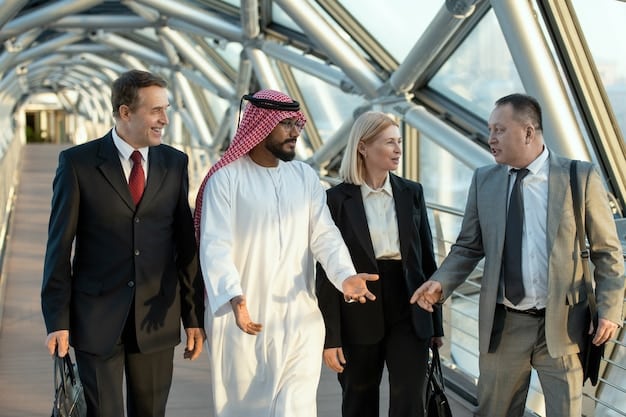US Role in Middle East Crisis: Conflict Resolution Analysis

The United States plays a multifaceted role in resolving international conflicts, demonstrated by its involvement in the Middle East crisis through diplomatic efforts, economic aid, and military presence, aiming to stabilize the region and protect its interests.
Understanding the Role of the US in Resolving International Conflicts: A Case Study of the Current Crisis in the Middle East is crucial for grasping global politics, examining the complexities, strategies, and impacts of American involvement in this turbulent region.
The Historical Context of US Involvement in the Middle East
The United States’ involvement in the Middle East has deep historical roots, tracing back to the post-World War II era. Understanding this history is essential to analyzing its current role in resolving conflicts.
Early Involvement and the Cold War
Initially, US interest in the Middle East was primarily driven by strategic concerns related to the Cold War and the need to secure access to the region’s vast oil reserves. This led to alliances and interventions that shaped the political landscape for decades.
The Impact of the Israeli-Palestinian Conflict
The Israeli-Palestinian conflict has been a central issue in US foreign policy in the Middle East, requiring continuous diplomatic engagement and mediation efforts. The US commitment to Israel’s security and its attempts to broker peace have significantly influenced regional dynamics.
- Strategic Alliances: Forming key partnerships with regional powers to counter Soviet influence.
- Oil Interests: Securing access to vital oil resources through diplomatic and sometimes military means.
- Mediation Efforts: Engaging in numerous peace initiatives, often with limited success.
The legacy of these historical engagements informs the current US approach to conflict resolution, highlighting both opportunities and challenges.
US Diplomatic Strategies in the Current Crisis
Diplomacy remains a key tool in the US approach to resolving the current crisis in the Middle East. These involve intricate negotiations, alliances, and strategic partnerships.
Negotiation and Mediation
The US often acts as a mediator in regional conflicts, facilitating talks between warring parties. These efforts aim to de-escalate tensions and find sustainable solutions.
Building Alliances and Partnerships
Forming strong alliances with key regional actors is another critical aspect of US diplomatic strategy. These partnerships provide support for stability and counter-terrorism efforts.

However, diplomatic efforts are often complicated by deep-seated mistrust and conflicting interests among regional stakeholders.
- High-Level Talks: Organizing and participating in high-level discussions to address immediate crises.
- Shuttle Diplomacy: Engaging in frequent travel between countries to facilitate communication and negotiation.
- International Forums: Leveraging international organizations like the UN to garner support for peace initiatives.
Navigating these challenges requires a nuanced understanding of the region’s complex dynamics.
Economic Aid and Its Influence on Conflict Resolution
Economic aid is a powerful tool that the US uses to influence conflict resolution in the Middle East. Its implications help in fostering stability and development.
Providing Humanitarian Assistance
Humanitarian aid is often provided to alleviate suffering and address the immediate needs of populations affected by conflict. This support can help build goodwill and reduce resentment.
Supporting Economic Development
Long-term economic development projects aim to create jobs, improve infrastructure, and foster sustainable growth. These initiatives can address some of the root causes of conflict.
But, the effectiveness of economic aid is often debated, with concerns about corruption, misuse of funds, and dependency.
- Direct Financial Aid: Providing direct monetary assistance to governments and organizations.
- Infrastructure Projects: Investing in essential infrastructure such as schools, hospitals, and roads.
- Training Programs: Supporting education and training programs to build local capacity.
Ensuring that aid reaches those who need it most and is used effectively is a significant challenge.
Military Presence and Operations: A Deterrent or Escalation?
The US military presence in the Middle East is a contentious issue, with debates over whether it serves as a deterrent or contributes to escalation. Understanding its impact is vital.
Counter-Terrorism Operations
A significant portion of US military activity in the Middle East is focused on counter-terrorism operations. These efforts target extremist groups and aim to prevent attacks.
Maintaining Regional Stability
The US military also plays a role in maintaining regional stability, deterring aggression, and protecting allies. This presence is seen by some as a necessary counterbalance to other regional powers.

Yet, the presence of foreign troops often fuels resentment and can be used by extremist groups to rally support.
- Air Strikes: Conducting targeted air strikes against terrorist targets.
- Ground Operations: Deploying ground troops for specific missions and training exercises.
- Naval Presence: Maintaining a naval presence in the region to protect shipping lanes and deter aggression.
Balancing security concerns with the potential for unintended consequences is a major challenge for US military policy.
The Role of Soft Power: Cultural and Educational Exchanges
Beyond military and economic strategies, the US also employs soft power through cultural and educational exchanges to influence perceptions and foster understanding.
Promoting Cultural Exchange
Cultural exchange programs aim to promote mutual understanding and respect between the US and Middle Eastern countries. These programs can help break down stereotypes and build bridges.
Educational Initiatives
Educational initiatives, such as scholarships and exchange programs, provide opportunities for students from the Middle East to study in the US and vice versa. These experiences can foster long-term relationships and understanding.
However, soft power efforts can be seen as attempts at cultural imperialism and may face resistance from those who are wary of Western influence.
- Scholarship Programs: Offering scholarships for Middle Eastern students to study in American universities.
- Cultural Events: Supporting cultural events and exhibitions that showcase American culture in the Middle East.
- Language Programs: Promoting the teaching of English and other languages to facilitate communication and understanding.
The effectiveness of soft power relies on genuine engagement and mutual respect.
Challenges and Criticisms of US Policy in the Middle East
US policy in the Middle East faces numerous challenges and criticisms, which are important to acknowledge when assessing its overall effectiveness.
Perceptions of Bias
One common criticism is that US policy is biased in favor of certain countries or groups, particularly Israel. This perception can undermine US credibility and complicate diplomatic efforts.
Unintended Consequences
Interventions in the Middle East have often had unintended consequences, such as the rise of extremist groups or the destabilization of entire regions. These outcomes raise questions about the effectiveness and wisdom of US policy.
Addressing these criticisms requires greater transparency, accountability, and a willingness to learn from past mistakes.
- Transparency: Being more open about the goals and methods of US policy.
- Accountability: Holding policymakers accountable for the outcomes of their decisions.
- Learning from Mistakes: Analyzing past failures to inform future strategies.
Ultimately, the success of US policy in the Middle East depends on its ability to adapt to changing circumstances and address legitimate concerns.
| Key Point | Brief Description |
|---|---|
| 🤝 Diplomacy | US mediates conflicts, builds alliances, and uses negotiation to address regional crises. |
| 💰 Economic Aid | Humanitarian assistance and development projects aim to stabilize the region. |
| 🪖 Military Presence | Counter-terrorism operations and maintaining regional stability are key objectives. |
| 📚 Soft Power | Cultural and educational exchanges promote understanding and build relationships. |
Frequently Asked Questions
▼
The primary goal is to promote stability, counter terrorism, and protect US interests, which include securing access to oil and ensuring the safety of allies in the region.
▼
Economic aid helps by providing humanitarian assistance, supporting economic development, and addressing the root causes of conflict, such as poverty and lack of opportunity.
▼
The main criticisms include perceptions of bias towards certain countries, unintended consequences of interventions, and questions about the effectiveness of military operations.
▼
Soft power promotes cultural exchange and educational initiatives, fostering mutual understanding and long-term relationships that can help reduce tensions and build bridges.
▼
Alliances are critical for maintaining regional stability, countering terrorism, and deterring aggression, providing support for US objectives and enabling collaborative efforts to address shared threats.
Conclusion
In conclusion, the Role of the US in Resolving International Conflicts: A Case Study of the Current Crisis in the Middle East is multifaceted, involving diplomatic, economic, military, and soft power strategies. While the US aims to promote stability and protect its interests, its policies face numerous challenges and criticisms. A balanced approach, addressing both security concerns and the root causes of conflict, is essential for long-term success in this turbulent region.





